
© Sascha Vaughan. (Click image for larger version)
www.trockadero.org
UK 2013 Tour – www.danceconsortium.com
Jann Parry’s interview with Paul Ghiselin (on Balletco archive)
Why it’s HOT to TROCK
Les Ballets Trockadero de Monte Carlo (more commonly known as The Trocks) is an all-male comedy dance ensemble founded in 1974. Based in New York, the company tours extensively and has a huge fan base around the world, not least in Japan and here in the UK. The Trocks begin another Dance Consortium tour with the first performance at The Lowry in Salford on 29th January. They then visit Birmingham, Canterbury, Nottingham, Bradford, Brighton, Newcastle and Edinburgh before concluding the season in Belfast on 27th February.
In late September the Trocks were performing at Les Folies Bergère in Paris. I reviewed the performance and also went backstage to talk with five of the Trocks and explore what it is like to be a part of this unique company.
These five dancers span the widest spectrum of experience from the two longest serving members to the newest recruit. Together with their on-stage pseudonyms (each Trock is given a humorous ballerina and danseur name), my “Folies Five” were:

© Sascha Vaughan. (Click image for larger version)
Paul Ghiselin (Ida Nevasayneva & Velour Pilleaux) joined in 1995 after a career in conventional ballet with Ohio Ballet and Festival Ballet of Rhode Island. He is now the company’s ballet master as well as its senior dancer. Paul celebrated his 51st birthday on the day before this interview (in September 2012);

© Sascha Vaughan. (Click image for larger version)
Robert Carter (Olga Supphozova & Yuri Smirnov) also joined in 1995, six months after Ghiselin, following training at the Joffrey Ballet School and performing with Dance Theater of Harlem ;
Raffaele Morra (Lariska Dumbchenko & Pepe Dufka) joined the Trocks in Milan during their tour in 2001;
Davide Marongiu (Giuseppina Zambellini & Ivan Legupski) is another Italian who was a former student at the English National Ballet School and became a Trock in 2005; and
Carlos Hopuy (Alla Snizova and Innokenti Smoktumuchsky) came from the National Ballet of Cuba, via the National Ballet of Costa Rica and Ballet San Antonio. His performance in the Black Swan pas de deux on the evening prior to this interview was only his third for the company, which he joined in the summer of 2012.
Graham Watts: How did you come to join the Trocks?
Robert Carter: I knew when I was a young boy that I wanted to be with the Trockadero. I started training at ballet when I was 7 and it has been my life ever since. I started with a local ballet school in South Carolina and I had an immediate fascination with pointe shoes. I would ask the girls, “if you have an old pair, don’t throw them out- give them to me”! I would play around with them on my own, after class, and one day I got busted by the teacher! But, instead of getting into trouble she suggested that I did the pointe class. Everything happens for a reason and so instead of practicing secretly I was able to go mainstream. I think the teacher encouraged me because she knew that it would make me want to keep on dancing (and it would strengthen my feet). After a while I started outfoxing some of the girls and she would ask me to demonstrate technique.
I came to New York and studied at the Joffrey School and with Dance Theatre Harlem. I knew about the Trocks from 11 or 12 because it was a group of guys doing what I wanted to do. I joined when I had just turned 20. I contacted Tory (Tory Dobrin, the artistic director) and he invited me over. I watched rehearsal and saw that the environment was very relaxed and easy. Then I came to take class and Tory asked me if I could come again tomorrow and when I walked in he gave me my contract and I’ve been there ever since.
Paul Ghiselin: I had known about Trockadero all my dancing life and I thought that it was just a great invention. I was approaching the end of my dancing career, in my mid-30s, and thinking of doing something that would be fun and enable me to see the world. To tell the truth, I was always the class clown and so people had often said to me, “you should think of joining the Trockadero”. So, eventually I went with that.
Raffaele Morra: The Company came to Torino where I was based (with Compagnia di Danza Teatro Nuovo di Torino). Miami City Ballet was performing in a Balanchine Festival and, straight after, the Trockadero came to the same theatre where they parodied the Balanchine style in Go for Barocco. I had seen the Miami Company but I fell in love with Les Ballets Trockadero de Monte Carlo and I thought this is what I want to do; this is the kind of show that I want to be in. Audiences are always having a wonderful time at their shows and the dancers are also having a lot of fun even though it is hard work. I was invited to take class with the company and Tory was looking for dancers for the annual Japan tour and so it was perfect timing. He said, “come and join us for this tour and we will see. If you like it, and we like you, you can stay”. Long before the end of the Japanese season I was sure that this was for me.

© Sascha Vaughan. (Click image for larger version)
Davide Marongiu: It turned out to be something I had always wanted to do but only once it had happened. The Company was in Paris and I was in my last year at ENB School, sending my resume everywhere. Tory asked me to Paris to take class and then invited me to come to NYC and rehearse for the upcoming tour to Japan. It was really sudden but it just felt that it was meant to be.

© Sascha Vaughan. (Click image for larger version)
Carlos Hopuy: I always wanted to be in the company since I first saw videos of the Trockadero in Cuba as a teenager. First, I left Cuba for Costa Rica, which is a good modern dance company, and then I came to New York. When I arrived in the US the first thing I did was watch everything on YouTube. Then I emailed the company, earlier this year, and they invited me to audition and gave me a contract straightaway. It was like fulfilling my dream.
GW: What was the big attraction?
Robert Carter: There was the humour of course but the main reason for wanting to join was that I could put on my pointe shoes and dance on stage. I couldn’t do that anywhere else. I had left Dance Theatre Harlem because I just wasn’t happy and I knew that I was destined to have a career in dance but I just hadn’t found my place. Watching that first rehearsal at the Trockadero changed everything for me.
Paul Ghiselin: I had studied acting as a teenager in high school and so I was very intrigued about the possibility of bringing this element with me into dance, especially in terms of humour. Dance isn’t one of those things that brings immediate humour – people don’t usually think, “I’m going to see the dance to have a belly laugh!” To me that was a very special element and here was also an opportunity to elongate my career.
Raffaele Morra: What interested me back then – in 2001 – and keeps interesting me even now is the fact that we always have a lot of fun. We take our job very seriously. We are professional dancers and we train every day but our performance brings so much laughter.
Davide Marongiu: Right from the beginning, I thought, “this is the company that I want to be in because it suited me so well.”

© Zoran Jelenic. (Click image for larger version)
Carlos Hopuy: I think that it is very interesting and challenging to dance like the Trocks. You have to have something in you that enables you to be funny. You can learn every day but it can’t easily be taught.

© Zoran Jelenic. (Click image for larger version)
GW: What is it like to be a Trock?
Raffaele Morra: I’m 37 and usually this is the age when people start to think about retirement and their future. But the special atmosphere in this company keeps me going. Paul was 51 yesterday and he’s still dancing. I joined this company because I loved the parody and the comedy and because of the response from the audience which is very immediate. It is very fulfilling for me as an artist to have the warmth of this reaction. Sometimes in a straight contemporary piece the audience is very quiet throughout and as the performer you have no idea if they like it or not: it is only at the end that they will applaud to show their appreciation. But with our work the applause is spontaneous and it is usually there right from the start.
Robert Carter: First and foremost we are a dance company. It takes a while to figure that out – it takes maturity and experience. I really like to know that I am doing something proper – you have to know how to do something well before you can send it up, which makes the argument that we respect greatly what we are doing. The comedy comes in as a commentary on a particular role or about a particular famous ballerina.
Davide Marongiu: Being a Trock is a mixture of so much hard work and satisfaction. From a deeper point of view it is the kind of job that can really drag you down if you don’t do it with glee. Being a Trock always reminds me that I am in a great place in my life. Throughout my seven years dancing here I have gone through so many things both in my professional and private life. This company and the beauty of this job has really saved me from gloom and thinking about the worst.
GW: What are the particular challenges to make the grade as a Trock?
Davide Marongiu: I have to say that some of my teachers and classmates at ENB came to see me during our season at the Peacock Theatre and they didn’t like what I was doing. They adored the Trocks but this is ENB and boys wearing pointe shoes was still not acceptable to them. So, it seems that being taken seriously is the biggest challenge. It was also hard for me to embrace the comic side because I was trained to take myself seriously. So it does take time and the most important thing that I learned was that you have to get over yourself in order to be able to make fun of yourself.

© Sascha Vaughan. (Click image for larger version)
Robert Carter: The biggest challenge is renewal. The Trockadero is like the inner workings of a clock – it is a machine that is constantly going. It is always a cycle repeating itself and we are always learning because there are new dancers all the time.
GW: Once you are here, it seems that it can be a job for life?
Paul Ghiselin: There is certainly nowhere else to go that is anything like the Trockadero. A dancer can continue to dance as long as their body holds up and they’re not fraught with horrible injuries. But you have to modify and you won’t have the stamina that you had when you were in your 30s. You are not going to go out night after night doing hard things but I think that part of the Trockadero is that the stress level here is very different from your normal classical ballet company. Because of the nature of the work, because it is fun, and this is a very supportive environment, people tend to last longer.
Robert Carter: I only took it one day at a time. I just wanted to have stability and it is ideal to stay with one company when you are happy. Once I reached that certain age that I might want to move, I realised that there wasn’t anywhere else that I wanted to be. I like to find my one place and if it ain’t broke then I don’t want to fix it. Yes, it is possible to have a longer performance life here. But, I am grounded and settled enough to believe that I will know when it is time to stop. I won’t be one of those people who refuse to leave.
Carlos Hopuy: You never know what tomorrow will bring but I love dancing here and so I can see me staying a Trock for a long time.
GW: There is always a set formula to any Trockadero programme. How do you keep it fresh?
Robert Carter: We are still evolving the roles all the time. There are always subtle differences in the ways of expression: it varies from performance to performance and from person to person. Some of these pieces I could do in my sleep, but it is not just about doing them, it is almost like playing a game. And so I take something to focus on and play around with, either stretch it to the limit or simplify it. It never gets stale.
Raffaele Morra: Although our formula is tried and tested we are always surprising people, even ourselves, with things that we might change. There is always the interpretation and the improvisation of the moment. The structure is the same but what we bring to it is going to be different from dancer to dancer. Just one look can make such a difference. From the technical point of view there is always the difference in the stage, the lights, the pointe shoes and the audience. I never feel exactly like I did on the previous day. We always bring ourselves to the stage and it is not like typing on the computer where the A is always in the same place. You always change.
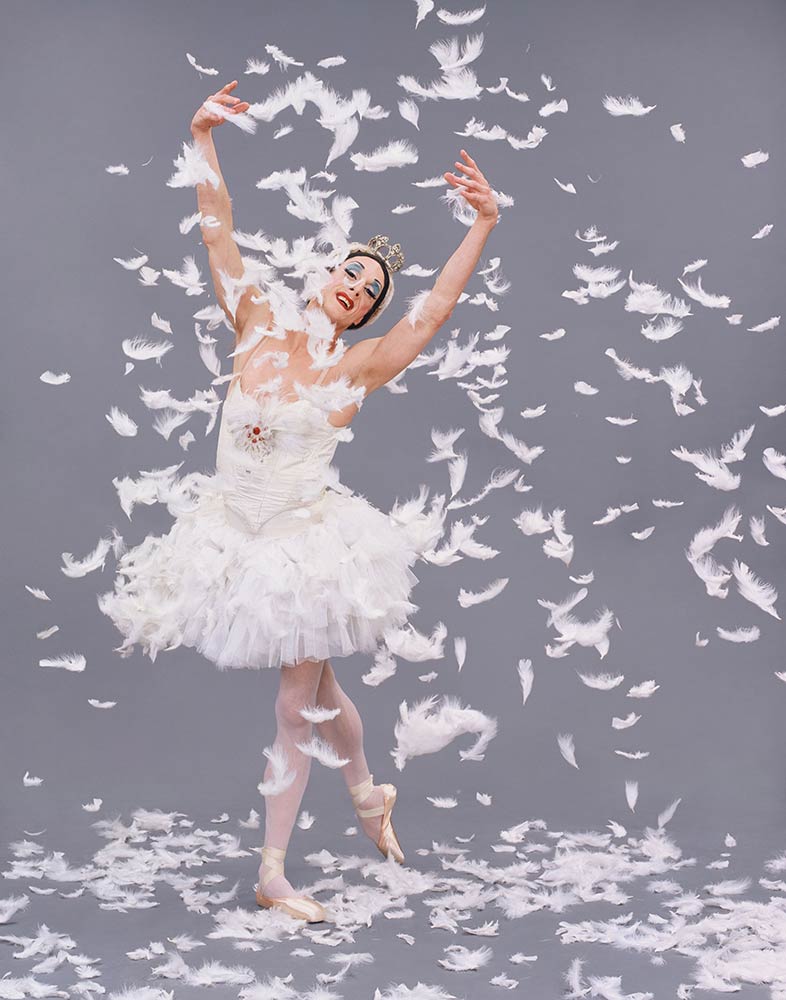
© Sascha Vaughan. (Click image for larger version)
My interpretation of The Dying Swan is very different from the one given by Paul (Ghiselin) because it is very important for every dancer to retain their personalities and to keep their performances fresh. Of course, we have some little jokes that are constant for all of us but beyond that we can be ourselves. For me that means being both Raffaele and Lariska but I’m also the dying swan and I also need to be Anna Pavlova – I need to be all of those things. And then there are always the outside influences. I’m doing The Dying Swan and someone is shooting me. I don’t know who is shooting and I don’t know if they are shooting me or Lariska. It is always very interesting for me to play this role and every night is different.
Davide Marongui: Sometimes I miss not taking ballet or myself seriously, because that was what I was trained to do but it always turns out that you can accommodate that within our own shows. There are times when it is not comedy, when I am taking myself seriously and the audience knows that. It may often be when I am dancing as a woman but it is nonetheless serious ballet. Take the three nymphs in Walpurgis Night, for example: it is a beautiful piece, really difficult and slow and that goes to the audience and they appreciate that. So, in the end, I know that I’m not missing anything.
GW: And a part of that formula is reviving old ballets that are rarely seen, such as The Little Humpback Horse and Walpurgis Night. How does that fit into the Trockadero ethos?
Raffaele Morra: Tory has the idea to revive these old ballets and we all agree that it is very good for us – as dancers – and it is also good for the audience because they don’t see those ballets any more. They are old-fashioned but we always give it a twist and make it modern again and people appreciate that. The parody is already there with the exaggeration in the style. We always try to keep the last act as an almost serious piece to finish with. We like to keep this balance.
Paul Ghiselin: We scour YouTube to find ideas for new-old work to develop. Then we hire in expert coaches to make it serious. I swear the Mariinsky only brought The Little Humpback Horse back because we were doing it!
GW: The comedy starts with the stage names each of you use throughout your time with the company. Tell me about the process of allocating names?
Robert Carter: We don’t get to choose our names so I was given Olga (Supphozova) nearly 18 years ago! There could be another Olga but I suspect that there will be a few names that are laid to rest when we hang our shoes up. By the way, no-one joins this company to do the male roles but they can sometimes be the funniest thing.
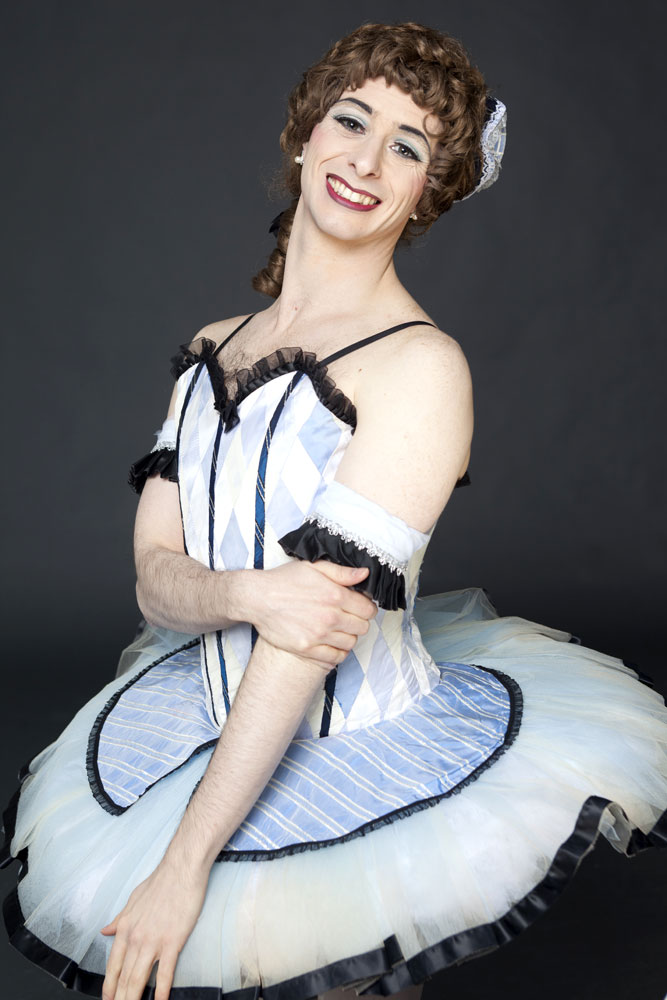
© Sascha Vaughan. (Click image for larger version)
Raffaele Morra: I was always Lariska (Dumbchenko) but I think that there was another one before me. There was a Margeaux Mundeyn (played by Yonny Manaure) that never came back. She lasted a long time and so it would have been wrong to recycle her name. But it is usual to recycle the names when the original is as good as Minnie Van Driver. Minnie works well for the new person (now Trystan Merrick) but it was perfect for the previous guy (Joseph Jefferies). Some names are still “resting”. We haven’t brought back Iona Trailer, yet!
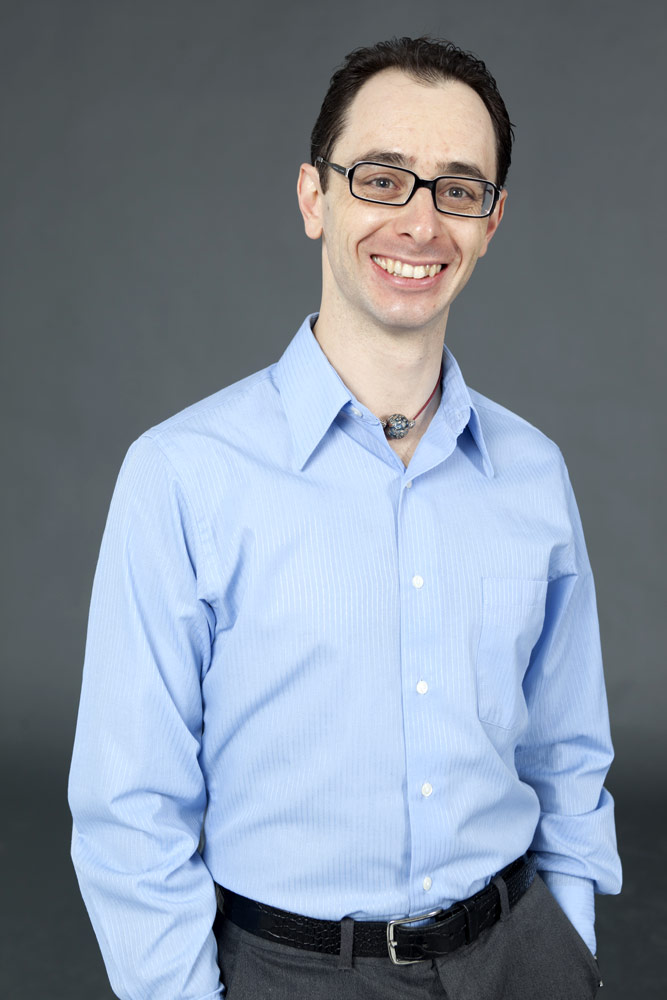
© Sascha Vaughan. (Click image for larger version)
Paul Ghiselin: We are never going to move Ida (Nevasayneva) on. I don’t think that they could. The name has become so much a part of me and I’ve become so much it.
Carlos Hopuy: I have become Alla Snizova and Innokenti Smoktumuchsky. They just told me “OK, Carlos, these are gonna be your names and you have to have a signature to match them”! They were names that came from before (Aviad Herman and Carlos Miller have both been Smoktumuchsky and Herman was also Snizova). I didn’t choose them but I like them because they are very funny. As a small guy, I think that I will be dancing as Innokenti a lot because I will be partnering the tall, beefy “ballerinas”!
GW: You are an ensemble of sixteen guys, regularly travelling the world together with newbies joining all the time. How does this work?
Paul Ghiselin: It is like a family dynamic. You set standards. You demand certain things, like respect because it can get very catty, very bitchy, when you have a room full of gay men. But it’s typical of any situation where you have highly strung artistic personalities in continuing close proximity. They can tend towards attacking one another. Here, we don’t put up with it. It gets stamped on straightaway! We demand things like being on time. We also require people to be civil to each other when they meet in the morning. We have a rule about “no complaining”. They can complain when it’s over and a past memory but when you are in the heart of it, there is nothing that you can do about a situation and so there is no point in sitting there and whining about it.
We have a collective consciousness. In a family, you don’t necessarily like all your relatives but you still understand that you have to be together and you learn to deal with one another. We have to avoid negativity taking hold, especially where the humour is concerned: because if someone is having a bad day, it shows. There has to be an infectious glee about the company, which needs to spread because we want our audiences to come and have a good time, above all else.
Touring can be very difficult. There was the occasion when the volcano erupted in Iceland and we were in Bilbao, Spain. Our next gig was in Budapest and we couldn’t fly. So, we had to take a bus across virtually the whole of Europe and then the next day, we had to wake up and do a show.
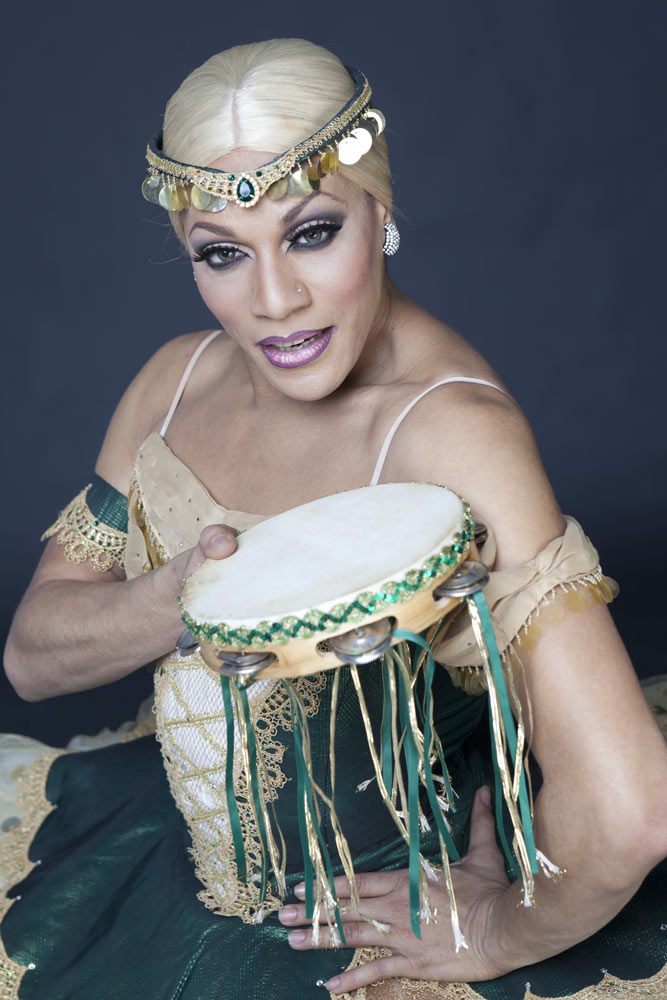
© Sascha Vaughan. (Click image for larger version)
Robert Carter: There are a lot of people who want to join this company but are just not cut out for it. There are great dancers who would not be able to handle the extent of our touring which brings with it a lot of responsibility. There is no group mother; there is no-one holding your hand; doing your laundry; going shopping for you; making sure that you eat well; getting your proper rest; and turning up to the theatre on time. So you have to put your “big boy pants” on and you have to do it.
Tory lays down the law and he looks for people who not only have great dancing skills but will also help to create and maintain the group atmosphere that encourages more and better work. We all get along; we are not all best friends but when it comes to the work we all have a shared dynamic and we know that if there is a problem we all need to get together and figure out a solution.

© Sascha Vaughan. (Click image for larger version)
Over the last couple of months (August/September 2012) we have had a big shift. We lost a lot of people at one time. When it comes to the new dancers I take it upon myself as one of the older more experienced dancers to show them certain tricks; suggest certain things for them that will make life a lot easier because I remember when I joined the company there were guys who had the time but they wouldn’t do that to help me. So, I had to sink or swim. There was a little bit of a jealousy factor. I was just happy to be in the company at the time but a lot of the existing dancers were threatened. They didn’t exactly encourage warm fuzzy feelings. So I make a point of doing this because it is about the whole good for everyone. It’s not my personality to work in a jealous environment because it only breeds negativity.
Raffaele Morra: It is not difficult to absorb new people but it is sometimes difficult for other people to let themselves into the company. The good thing is that we are always having a lot of fun so it should be easy to become a part of it. The group is very welcoming. Tory always says that Les Ballets Trockadero de Monte Carlo is like a village. When you have a new person in your community you have to welcome them and we are like that. The senior members have a big responsibility for making people feel accepted but they have to want to be accepted. Usually that happens.
Carlos Hopuy: Like every company, we have rules for everything, which are very clear. Everyone is always so kind. When I came here to Paris, they helped me with everything, including my make-up!
I’m looking forward to the touring. Discovering different places is something that I have always wanted to do. I don’t understand how anyone could think it was difficult.
Davide Marongui: As an Italian, home is really important to me. And my home is now in New York, which is beautiful but it is also a really tough city to live in. I love New York but the city keeps challenging you every day: with money, with status, with friendships and relationships. If you take this challenge and add it to the constant travelling it is really easy to get into a lonely and desperate state of mind. It is certainly a situation that could put you in touch with your inner self, perhaps more than you would want. But being part of this big, extended family makes it all better.

© Sascha Vaughan. (Click image for larger version)
GW: You tour the UK regularly. What does it mean to you?
Paul Ghiselin: My first visit to London with the Trockadero was in the Fall of 1997. We arrived the day that they picked up the flowers from Diana’s memorial. I dropped my bags at the hotel and got straight on the bus to the Palace to see this amazing thing. It was incredibly touching and it had a very strong impact on me. The timing was perfection for us. England had gone through this great period of mourning and people were ready to say, “come on we have to refresh ourselves and get going again”. And there we were!
GW: Do you still have dancing dreams?
Carlos Hopuy: I really, really want to dance the Swan Queen. That is my dream. But also, I am really keen to dance Albrecht in Giselle.
Robert Carter: Whatever I do, I’d have to have my pointe shoes. My ultimate dream would be to do the full Swan Lake, for serious, with myself in the lead but surrounded by a corps de ballet of women.
My other thing is that I would love to teach. I want to be part of the staff to groom future Trocks and to pass on what I know and preserve what we do. Perhaps there is scope for a Trocks’ school? Nowadays, there are still a lot of people with very strong opinions and I would love to help young men who were like me. I want to make them realise that there is nothing wrong with what they want to do and it can lead to a satisfying and sustainable career.







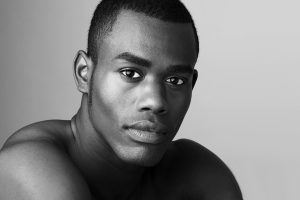




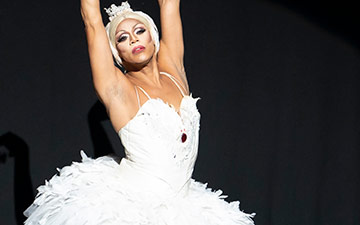

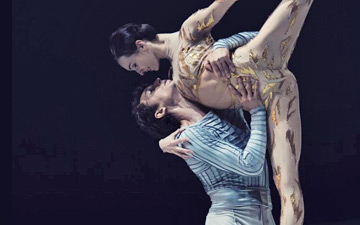


Long live the Trocks!!!!
Love the Trocks I always enjoy their shows that I am fortunate enough to see. I am also happy to see the togetherness of the dancers to each other.It seems that all members are concerned with the the goals of the company and that is to give the best possible performances for the audiences.
I don’t want anyone to ever think that they are just comediennes that dance. They are dancers that perform in a comedic fashion. I can vouch for the hard work that has gone into perfecting their craft. May the Trocks continue to thrill audiences forever.
I’ve been watching the Trocks since 1977 and was so sad when they stopped coming to the San Francisco Bay Area on a regular basis. The company dances at an artistic level far superior most other ballet companies and proves that hard work and having fun aren’t mutually exclusive.